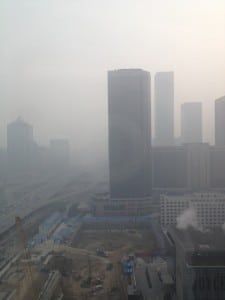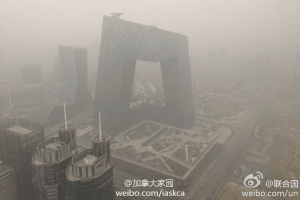 To breathe in Beijing is to participate in a human tragedy of sorts; a scene so draconian, so morbid, and (as days of persistent nosebleeds and headaches can attest) so viscerally offensive that it begs the question: what have we done?
To breathe in Beijing is to participate in a human tragedy of sorts; a scene so draconian, so morbid, and (as days of persistent nosebleeds and headaches can attest) so viscerally offensive that it begs the question: what have we done?
It was midday and the city was dark. I was staring directly at the sun, but all I saw was a faint circular amber glow. In other words, it was an otherwise perfectly sunny, cloudless day, but the air was so thick that the sky was lightless… lifeless. Indeed, reports confirmed that last week was the worst air pollution China’s capital has ever recorded (concentration of PM2.5 particles now easily exceed 800 mcg/m^3).
Over and over I am asked by friends around the world to describe the air. Here’s the best I can do:
1. Imagine placing a sheet of steel into an impossibly high-powered blender. Allow this blender to shred the steel into a microscopic pulp, and then inhale.
2. Imagine breathing in the smoky air at the heart of Idaho’s 2012 wildfires during their most violent moment. Readings show that Beijing’s pollution last week was over five times worse than that*.
3. Post-apocalyptic.
It’s worth mentioning that Beijing has a fair share of pollution-free days, and on those days, the city is spectacular. Perhaps it’s memories of those beautiful days, that knowledge of what Beijing can be when not suffocating under this poison cloth of toxicity, that made the scene before me so heartbreaking.
Beijing’s pollution problem is unique in its egalitarianism. Those of us braving the streets and perched in towering office and government buildings all breathe about 15 times per minute, and into our lungs and bloodstream we invite a potent cocktail of 2.5mcg particles, the output of our machines, in hopes that the death we inhale breathes life into the economy.
Is this the society we want for ourselves? Is it the air we want our babies breathing?
I hope the sight before my eyes will never again be seen by any human, anytime, anywhere. We can, and must, do better.
*(163 mcg/m^3 v Beijing’s current 845 mcg/m^3)
 在北京呼一口气可谓是参与了一场人类悲剧。这场面十分残酷、
在北京呼一口气可谓是参与了一场人类悲剧。这场面十分残酷、
现在是北京时间12点,但北京却黑蒙蒙的一片。我努力直视太阳,


